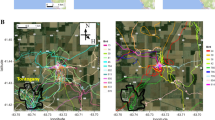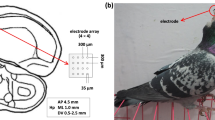Summary
Homing pigeons were subjected to either hippocampal or control anterior forebrain ablations to examine what role the hippocampus and related structures may play in homing behavior. One year after surgery, the test birds were released from five locations where they had never been before. Both groups were successful in orienting homeward from the release sites, indicating that the hippocampus is not necessary for the neural regulation of a pigeon's map and compass system. Nonetheless, hippocampal ablated pigeons were significantly poorer with respect to the time required to return home, indicating a homing performance impairment. Alternative hypotheses are discussed to explain this result, the most parsimonious being impaired ability on the part of the hippocampal ablated birds to direct a course homeward.
Similar content being viewed by others
References
Batschelet E (1981) Circular statistics in biology. Academic Press, New York
Bingman VP, Bagnoli P, Ioalé P, Casini G (1984) Homing behavior of pigeons after telencephalic ablations. Brain Behav Evol 24:94–108
Bingman VP, Ioalé P, Casini G, Bagnoli P (1985) Dorsomedial forebrain ablations and home loft association behavior in homing pigeons. Brain Behav Evol 26:1–9
Bingman VP, Ioalé P, Casini G, Bagnoli P (1987a) Pigeon homing and the avian hippocampal complex: a complementary experimental paradigm. In: Ellen P, Thinus-Blanc C (eds) Cognitive processes and spatial orientation in animals and man. Nijhof Press, Dordrecht, Netherlands, pp 273–283
Bingman VP, Ioalé P, Casini G, Bagnoli P (1987b) Impaired retention of preoperatively acquired spatial reference memory in homing pigeons following hippocampal ablation. Behav Brain Res 24:147–156
Bingman VP, Ioalé P, Casini G, Bagnoli P (in press) Unimpaired acquisition of spatial reference memory, but impaired homing performance in hippocampal ablated pigeons. Behav Brain Res
Casini G, Bingman VP, Bagnoli P (1986) Connections of the pigeon dorsomedial forebrain studied with WGA-HRP and H3proline. J Comp Neurol 245:454–470
Craigie E (1930) Studies on the brain of the kiwi (Apteryx australis). J Comp Neurol 56:223–357
Ewert J-P, Capranica R, Ingle D (eds) (1983) Advances in vertebrate neuroethology. Plenum Press, New York
Foá A, Bagnoli P, Giongo F (1986) Homing pigeons subjected to section of the anterior commissure can build up two olfactory maps in the deflector lofts. J Comp Physiol A 159:465–472
Karten H, Hodos W (1967) A stereotaxic atlas of the brain of the pigeonColumba livia. Johns Hopkins Press, Baltimore
Kramer G (1953) Die Sonnenorientierung der Vögel. Verh Dt Zool Ges 1952:72–84
Krayniak P, Siegel A (1978) Efferent connections of the hippocampus and adjacent regions in the pigeon. Brain Behav Evol 15:372–388
Michener M, Walcott C (1967) Homing of single pigeons — an analysis of tracks. J Exp Biol 47:99–131
Morris R, Garrud P, Rawlins J, O'Keefe J (1982) Place navigation impaired in rats with hippocampal lesions. Nature 297:681–683
O'Keefe J, Nadel L (1978) The hippocampus as a cognitive map. Clarendon Press, Oxford
Olton D, Becker S, Handelmann J (1980) Hippocampal function: Working memory or cognitive mapping. Physiol Psychol 8:239–246
Papi F (1982) Olfaction and homing in pigeons: Ten years of experiments. In: Papi F, Wallraff H (eds) Avian navigation. Springer, Berlin Heidelberg New York, pp 149–159
Papi F, Wallraff H (1982) Avian navigation. Springer, Berlin Heidelberg New York
Schmidt-Koenig K, Walcott C (1978) Tracks of pigeons homing with frosted lenses. Anim Behav 26:480–486
Seifert W (1983) Neurobiology of the hippocampus. Academic Press, New York
Semm P, Demaine C, Wiltschko W (1984) Neural basis of the magnetic field compass: interactions of visual, magnetic and vestibular inputs in the pigeon's brain. J Comp Physiol A 155:283–288
Semm P, Demaine C (1986) Neurophysiological properties of magnetic cells in the pigeon's visual system. J Comp Physiol A 159:619–625
Siegel S (1956) Nonparametric statistics. McGraw Hill, New York
Walker J, Olton D (1984) Fimbria-fornix lesions impair spatial working memory but not cognitive mapping. Behav Neurosci 2:226–242
Author information
Authors and Affiliations
Rights and permissions
About this article
Cite this article
Bingman, V.P., Ioalé, P., Casini, G. et al. Hippocampal ablated homing pigeons show a persistent impairment in the time taken to return home. J. Comp. Physiol. 163, 559–563 (1988). https://doi.org/10.1007/BF00604909
Accepted:
Issue Date:
DOI: https://doi.org/10.1007/BF00604909




